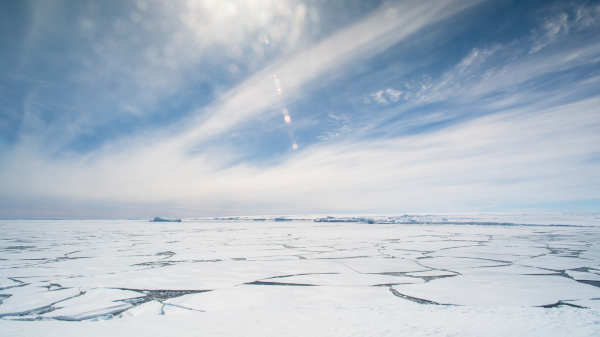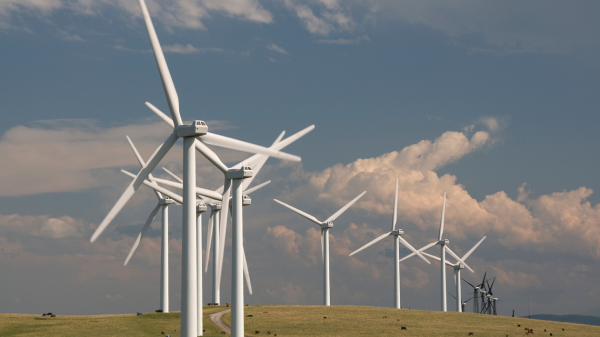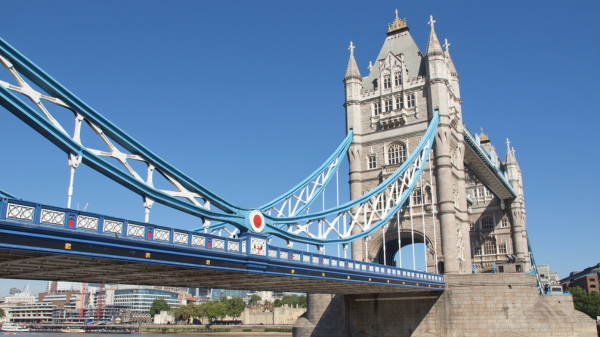IN THIS ISSUE:
- Polar Ice Is Not Following the Climate Crisis Narrative
- Noise Impact on Health Causes Irish Court to Shut Down Wind Turbines
- Extreme High Temperatures in the United Kingdom Recorded at Junk Sites Crisis Narrative

Polar Ice Is Not Following the Climate Crisis Narrative
In late April and early May, mainstream media outlets ran dozens of stories discussing the findings of a recent study that showed Antarctica’s ice mass was growing. The outlets called the ice and snow gain “astonishing,” “surprising,” and “shock[ing]” and said it “startled the scientific community.” Perhaps they were surprised because they rely on climate models to inform them what is or should be happening in Antarctica, or perhaps they found the gains unexpected simply because it didn’t play into the climate crisis narrative.
They may have been astonished or surprised, but I wasn’t. Having examined the data and history, I knew Antarctica has not been following the climate crisis script since the alarm was first raised with James Hansen’s theatrically staged 1988 congressional testimony in which he claimed the Earth was dangerously warming due to human activity.
Climate theory and the models say the warming of the Earth should be greatest at the poles. But while the Arctic has warmed more than the average for the globe as whole, the South Pole has experienced little or no warming. In fact, a 2020 study published in the journal Nature found Antarctica had not experienced any measurable warming for the past 70 years.
“The Antarctic continent has not warmed in the last seven decades, despite a monotonic increase in the atmospheric concentration of greenhouse gases,” the researchers wrote, also noting “Antarctic sea ice area has modestly expanded” over the past several decades.
Examining the recent study in more detail, rather than the media reports about it, what it found is that after a glacial decline from 2011 through 2020, four large glacier basins in East Antarctica—the east and central part of the continent making up the vast bulk of it—have had substantial ice growth. Glacial melt which had been contributing to sea level rise reversed itself over a period of three years, adding mass and cutting Antarctica’s contribution to sea level rise.
“Antarctica gains ice for first time in decades, reversing trend of mass loss,” wrote Fox News in reporting on the study. “A surprising shift is underway at the bottom of the world. After decades of contributing to rising sea levels, Antarctica’s massive ice sheet has started growing again—at least for now.”
As important as the study may be for understanding the very recent ice balance and trends in Antarctica, I don’t think its analysis of past ice trends or levels is entirely accurate. Research from NASA in 2015 found “an increase in Antarctic snow accumulation that began 10,000 years ago is currently adding enough ice to the continent to outweigh the increased losses from its thinning glaciers.” If NASA’s 2015 findings are correct, it means the ice accretion of the past few years isn’t merely the first time in decades that Antarctica has produced a net ice gain but rather is at most the first time in a decade.
To be fair, because the earlier study debunked commonly asserted alarmist claims that Antarctica was suffering a massive ice loss that would lead to massive global sea level rise if unabated, NASA tried to bury its own report or at least raise questions about its validity. On NASA’s webpage, after a brief paragraph describing the NASA researchers’ results based on satellite measurements, one now finds this:
NOTE: The findings reported here conflict with over a decade of other measurements, including previous NASA studies. However, challenges to existing findings are an integral part of the scientific process and can help clarify and advance understanding. Additional scrutiny and follow-up research will be required before this study can be reconciled with the preponderance of evidence supporting the widely accepted model of a shrinking Antarctic ice sheet. (Italics in the original)
Regardless of whether NASA was right in 2015 or the new study is more accurate, Antarctica is not behaving as harbingers of climate doom said it should, having used their unvalidated computer models’ projections. As skeptics like myself constantly remind the public, the climate is more complex than climate models and those who rely on them believe them to be. To paraphrase Shakespeare, “There are more things in Heaven and Earth than are imagined in the climate cabal’s philosophy.”
None of the above says there is no melting of ice in Antarctica. West Antarctica and the Antarctic peninsula have lost ice at increasing rates over the past couple of decades, resulting in headline-making glacier calving accompanied by breathless stories about inevitable sea level rise unless fossil fuel use is halted. The problem is, based on temperature and ocean current data, the ice loss on the peninsula is more likely attributable to a shift in large-scale ocean currents affecting ocean temperatures, and the best evidence suggests much of the ice loss in the West Antarctic is due to subsurface geothermal activity melting ice there from below and causing ice to flow faster. That means climate change isn’t an identifiable factor in the melting in either location.
In addition, Central and East Antarctica are by far the largest portions of the continent, so the evidence suggests any ice loss in the western portion of the continent is likely being more than offset by gains on the mainland and in the Eastern glacial basins. As a result, Antarctica may be a net sea level sink, rather than contributing to rising seas.
Sources: Science China Earth Sciences; CO2 Coalition; Fox News; Climate Cosmos; Climate Realism; NASA; Climate Realism

Noise Impact on Health Causes Irish Court to Shut Down Wind Turbines
Add Wexford, Ireland to the growing list of jurisdictions holding industrial wind owners and operators responsible for the health impacts their facilities impose on people.
The high court in Dublin, Ireland ordered an industrial wind facility in rural Wexford, Ireland to cease operating half of its wind turbines in the region, recognizing the harm done to rural residents by the noise and flickering lights from the turbines’ operations.
In addition to ordering the Wexwind facility to shut down three of its six turbines, the judge ordered the company to compensate local residents for noise nuisance. Justice Oisin Quinn ordered Wexwind to pay the plaintiffs $343,000 in compensation for the nuisance and more than $69,000 in “aggravated damages. The judge left open until later what to do about court costs and the plaintiffs’ solicitor’s fees.
Going forward, mitigating noise and shadow flicker (strobe light effect) nuisance will be “critical to the future success of wind as a major source of renewable energy,” an expert witness told the court.
Author and energy analyst Robert Bryce notes this is not the first case in which courts have ruled against industrial wind facilities for the health impacts their operations have imposed on adjacent landowners, which the operators have tried to downplay or cover up. Bryce writes,
[T]he undeniable truth is that noise pollution is pollution, and prolonged exposure to noise pollution harms human health.
Of course, Big Wind has known about the noise pollution issue for years but has refused to admit it harms people. … Over the past few years, NextEra Energy, the world’s biggest producer of solar and wind energy, and other alt-energy companies have quietly settled a number of lawsuits filed against them by landowners who have cited turbine noise in their legal complaints.
Numerous studies have found that turbine noise is a problem. In 2009, a study by the Minnesota Department of Health detailed the problems associated with noise from wind turbines. The key passage says, “The most common complaint in various studies of wind turbine effects on people is annoyance or an impact on quality of life. Sleeplessness and headache are the most common health complaints.”
In 2010, Dr. Michael Nissenbaum, a radiologist in Fort Kent, Maine, did a landmark study .. finding: 82% of the residents living within about 1,100 meters of the wind turbines complained of sleep disturbance. …
[A] 2012 literature review found that when turbines are located too close to homes, “The prolonged exposure to the audible and inaudible range of acoustic characteristics of wind turbine noise adversely affects people’s health.”
As Bryce details, courts in France have also ordered wind facilities to pay damages for noise health harms and to shut down and remove turbines, restoring the land to its natural state.
In addition, more than 700 cities, towns, and counties across the United States have banned industrial wind development within their jurisdictions, citing health concerns, lowering of property values, and environmental damage.
Source: Robert Bryce; Recharge News

Extreme High Temperatures in the United Kingdom Recorded at Junk Sites
In mid-May the United Kingdom weather service, the Met Office, reported extremely high temperatures at various locations across the country—when much of the nation was experiencing a nice, warm spring.
Investigative journalists at The Daily Skeptic (DS) examined the data and found nine out of 10 local temperature stations reporting “extreme” daily temperature highs for the nine days from May 10 through May 18 were what the DS referred to as “junk” sites, meaning they were in the worst two classes, Class 4 and Class 5, of temperature stations for accuracy in recording temperatures. Class 4 and 5 sites have “internationally-recognised ‘uncertainties’ of 2°C and 5°C respectively.” That means temperatures recorded at these sites could be as much as two (Class 4) to five (class 5) degrees lower or higher than the reported temperatures.
Chris Morrison, author of the DS story, notes certain junk locations regularly and repeatedly report unusual highs and “the recording of highs in these corrupted sites didn’t mean the air temperature was representative of the wider surrounding area. It just meant that the sites were poorly located next to unnatural heat sources and were producing a false natural air record, recently re-badged by the Met Office as a so-called ‘extreme’ high.”
“Every day the Met Office posts a daily high temperature for 16 locations around the UK,” writes Morrison. “In the nine consecutive days under review, I initially found that 83.8% of the highs were recorded in Class 4 and 5 sites rated by the World Meteorological Organization to have the large ‘uncertainties’ up to 5°C.
“No less than 36.6% of records came from Class 5 sites that have no qualifying criteria for accuracy and can be located anywhere,” writes Morrison.
Of course, as detailed by Heartland’s own Anthony Watts in a series of reports, the U.K. is not alone in reporting data from poorly sited temperature stations that violate basic principles of data quality by using urban heat island biased temperature measurements. Watts’ most recent study, published in 2022, found roughly 96 percent of the temperature stations in the United States used to measure climate change fail to meet the National Oceanic and Atmospheric Administration’s standards for acceptable and uncorrupted placement.
Additionally, in the June 5 Climate Change Weekly I discussed research published in the Journal of Applied Meteorology and Climatology in April that found increasing population density around and near surface station locations was highly correlated with quickly rising temperatures, with those temperatures biasing the reported average temperature for the United States as a whole.
In temperature measurements and reporting as with computing, the same rule applies: garbage in, garbage out.
Sources: The Daily Skeptic; The Heartland Institute; Climate Change Weekly





